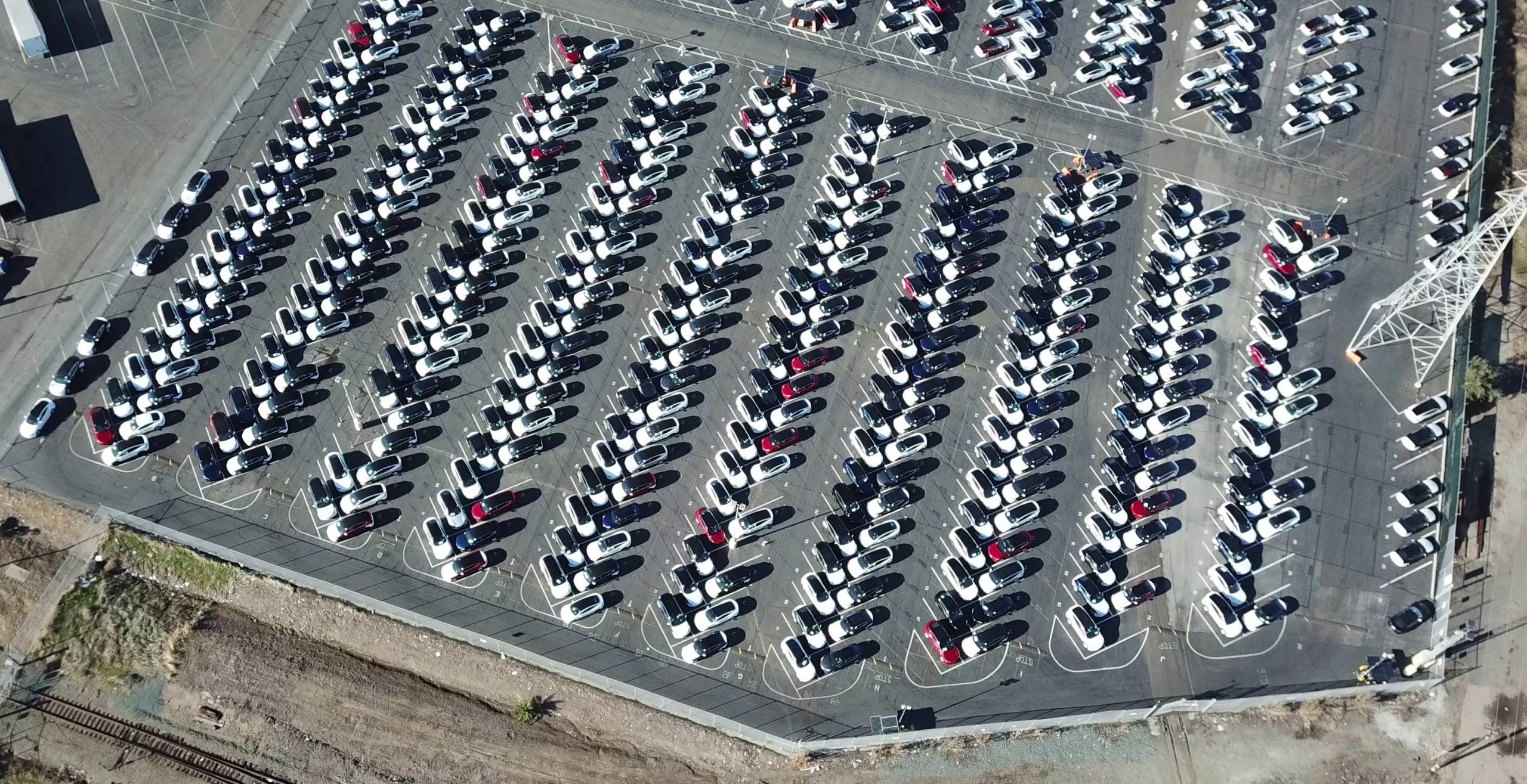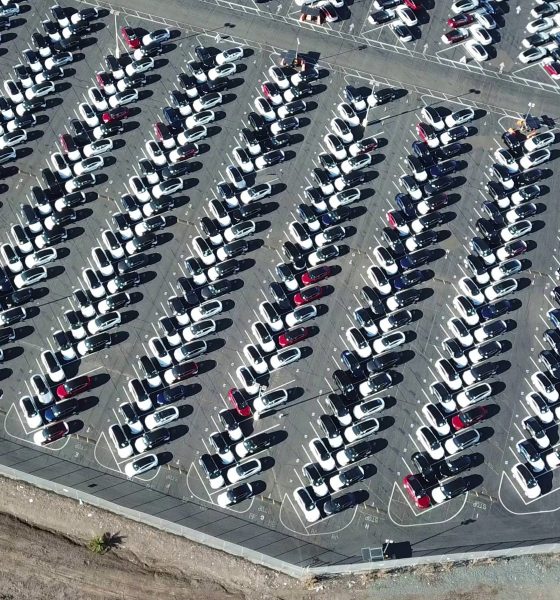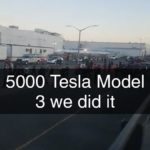

Investor's Corner
Tesla Model 3 production hits 5k/week, 7k including Model S & Model X
Tesla has managed to scale Model 3 production to 5,000 vehicles per week. As noted by Elon Musk in an email to employees, Tesla did not only produce 5,000 Model 3 in seven days; it was also able to maintain the pace of 2,000 vehicles per week for the Model S and Model X.
The signs were already there in the days leading up to the end of the second quarter. This weekend alone, a series of images from workers at Fremont were uploaded on social media, suggesting that the company had hit its all-elusive production goal for the compact electric car. Among the most prominent was a “Model 3 5k Club” banner with signatures of workers from the Fremont factory. Casual snapshots from the facility’s grounds and assembly line, as well as a vehicle labeled “5000th” on its windshield, also suggested that the company had produced its 5,000th Model 3 for the week.
- [Credit: Tesla Daily/Twitter]
- [Credit: Tesla Daily/Twitter]
- [Credit: Tesla Daily/Twitter]
- [Credit: The Tesla Life/Twitter]
While the images coming out from Fremont incited speculations, they were eventually confirmed by a leaked email from Elon Musk himself. A partial copy of Musk’s email was provided to Teslarati by an anonymous insider.
“We did it!! What an incredible job by an amazing team. Couldn’t be more proud to work with you. It’s an honor. The level of dedication and creativity was mind-blowing. We either found a way or, by will and inventiveness, created entirely new solutions that were thought impossible.
“Intense in tents. Transporting entire production lines across the world in massive cargo planes. Whatever. It worked. Not only did we factory gate over 5,000 Model 3’s, but we also achieved the S & X production target for a combined 7,000 vehicle week!”
The 5,000/week target for the Model 3 has proven to be elusive for the electric car and energy company. During the vehicle’s unveiling last year, Elon Musk estimated that Tesla could attain the milestone by the end of 2017. When the company failed to hit this goal, Tesla opted to move the deadline to the second quarter of 2018, placing a target of 2,500 Model 3 per week at the end of Q1 2018.
Tesla did not meet this goal, though it did manage to manufacture more than 2,000 vehicles during the final week of March. During the 2018 Annual Shareholder Meeting, however, Elon Musk announced that Tesla was on track to hitting its 5,000/week target by the end of Q2 2018. Musk’s reassurance ultimately helped push Tesla stock towards a meteoric rise, at one point even coming close to its all-time high.
Tesla’s Model 3 production milestone did not come easy for the Elon Musk-led company. During the second quarter, the company had to shut down the vehicle’s manufacturing twice to make way for upgrades on the production line. New robots and other machinery were also flown in from Europe to Gigafactory 1 in order to help address bottlenecks in the production of the vehicles’ battery packs.
In an unprecedented move this June, Tesla also erected a massive sprung structure on the grounds of the Fremont factory to house another assembly line for the Model 3. The move, deemed “insanity” by critics, ultimately allowed the company to augment its capability to manufacture the compact electric car.
According to a Reuters report, Tesla is now targeting a pace equivalent to 6,000 Model 3 per week within the next month. As noted by Elon Musk in his email to employees, the recently attained milestone might have very well established Tesla as a formidable car maker.
“I think we just became a real car company,” Musk wrote.

Investor's Corner
Tesla stock closes at all-time high on heels of Robotaxi progress

Tesla stock (NASDAQ: TSLA) closed at an all-time high on Tuesday, jumping over 3 percent during the day and finishing at $489.88.
The price beats the previous record close, which was $479.86.
Shares have had a crazy year, dipping more than 40 percent from the start of the year. The stock then started to recover once again around late April, when its price started to climb back up from the low $200 level.
This week, Tesla started to climb toward its highest levels ever, as it was revealed on Sunday that the company was testing driverless Robotaxis in Austin. The spike in value pushed the company’s valuation to $1.63 trillion.
Tesla Robotaxi goes driverless as Musk confirms Safety Monitor removal testing
It is the seventh-most valuable company on the market currently, trailing Nvidia, Apple, Alphabet (Google), Microsoft, Amazon, and Meta.
Shares closed up $14.57 today, up over 3 percent.
The stock has gone through a lot this year, as previously mentioned. Shares tumbled in Q1 due to CEO Elon Musk’s involvement with the Department of Government Efficiency (DOGE), which pulled his attention away from his companies and left a major overhang on their valuations.
However, things started to rebound halfway through the year, and as the government started to phase out the $7,500 tax credit, demand spiked as consumers tried to take advantage of it.
Q3 deliveries were the highest in company history, and Tesla responded to the loss of the tax credit with the launch of the Model 3 and Model Y Standard.
Additionally, analysts have announced high expectations this week for the company on Wall Street as Robotaxi continues to be the focus. With autonomy within Tesla’s sights, things are moving in the direction of Robotaxi being a major catalyst for growth on the Street in the coming year.
Elon Musk
Tesla needs to come through on this one Robotaxi metric, analyst says
“We think the key focus from here will be how fast Tesla can scale driverless operations (including if Tesla’s approach to software/hardware allows it to scale significantly faster than competitors, as the company has argued), and on profitability.”

Tesla needs to come through on this one Robotaxi metric, Mark Delaney of Goldman Sachs says.
Tesla is in the process of rolling out its Robotaxi platform to areas outside of Austin and the California Bay Area. It has plans to launch in five additional cities, including Houston, Dallas, Miami, Las Vegas, and Phoenix.
However, the company’s expansion is not what the focus needs to be, according to Delaney. It’s the speed of deployment.
The analyst said:
“We think the key focus from here will be how fast Tesla can scale driverless operations (including if Tesla’s approach to software/hardware allows it to scale significantly faster than competitors, as the company has argued), and on profitability.”
Profitability will come as the Robotaxi fleet expands. Making that money will be dependent on when Tesla can initiate rides in more areas, giving more customers access to the program.
There are some additional things that the company needs to make happen ahead of the major Robotaxi expansion, one of those things is launching driverless rides in Austin, the first city in which it launched the program.
This week, Tesla started testing driverless Robotaxi rides in Austin, as two different Model Y units were spotted with no occupants, a huge step in the company’s plans for the ride-sharing platform.
Tesla Robotaxi goes driverless as Musk confirms Safety Monitor removal testing
CEO Elon Musk has been hoping to remove Safety Monitors from Robotaxis in Austin for several months, first mentioning the plan to have them out by the end of 2025 in September. He confirmed on Sunday that Tesla had officially removed vehicle occupants and started testing truly unsupervised rides.
Although Safety Monitors in Austin have been sitting in the passenger’s seat, they have still had the ability to override things in case of an emergency. After all, the ultimate goal was safety and avoiding any accidents or injuries.
Goldman Sachs reiterated its ‘Neutral’ rating and its $400 price target. Delaney said, “Tesla is making progress with its autonomous technology,” and recent developments make it evident that this is true.
Investor's Corner
Tesla gets bold Robotaxi prediction from Wall Street firm
Last week, Andrew Percoco took over Tesla analysis for Morgan Stanley from Adam Jonas, who covered the stock for years. Percoco seems to be less optimistic and bullish on Tesla shares, while still being fair and balanced in his analysis.

Tesla (NASDAQ: TSLA) received a bold Robotaxi prediction from Morgan Stanley, which anticipates a dramatic increase in the size of the company’s autonomous ride-hailing suite in the coming years.
Last week, Andrew Percoco took over Tesla analysis for Morgan Stanley from Adam Jonas, who covered the stock for years. Percoco seems to be less optimistic and bullish on Tesla shares, while still being fair and balanced in his analysis.
Percoco dug into the Robotaxi fleet and its expansion in the coming years in his latest note, released on Tuesday. The firm expects Tesla to increase the Robotaxi fleet size to 1,000 vehicles in 2026. However, that’s small-scale compared to what they expect from Tesla in a decade.
Tesla expands Robotaxi app access once again, this time on a global scale
By 2035, Morgan Stanley believes there will be one million Robotaxis on the road across multiple cities, a major jump and a considerable fleet size. We assume this means the fleet of vehicles Tesla will operate internally, and not including passenger-owned vehicles that could be added through software updates.
He also listed three specific catalysts that investors should pay attention to, as these will represent the company being on track to achieve its Robotaxi dreams:
- Opening Robotaxi to the public without a Safety Monitor. Timing is unclear, but it appears that Tesla is getting closer by the day.
- Improvement in safety metrics without the Safety Monitor. Tesla’s ability to improve its safety metrics as it scales miles driven without the Safety Monitor is imperative as it looks to scale in new states and cities in 2026.
- Cybercab start of production, targeted for April 2026. Tesla’s Cybercab is a purpose-built vehicle (no steering wheel or pedals, only two seats) that is expected to be produced through its state-of-the-art unboxed manufacturing process, offering further cost reductions and thus accelerating adoption over time.
Robotaxi stands to be one of Tesla’s most significant revenue contributors, especially as the company plans to continue expanding its ride-hailing service across the world in the coming years.
Its current deployment strategy is controlled and conservative to avoid any drastic and potentially program-ruining incidents.
So far, the program, which is active in Austin and the California Bay Area, has been widely successful.













